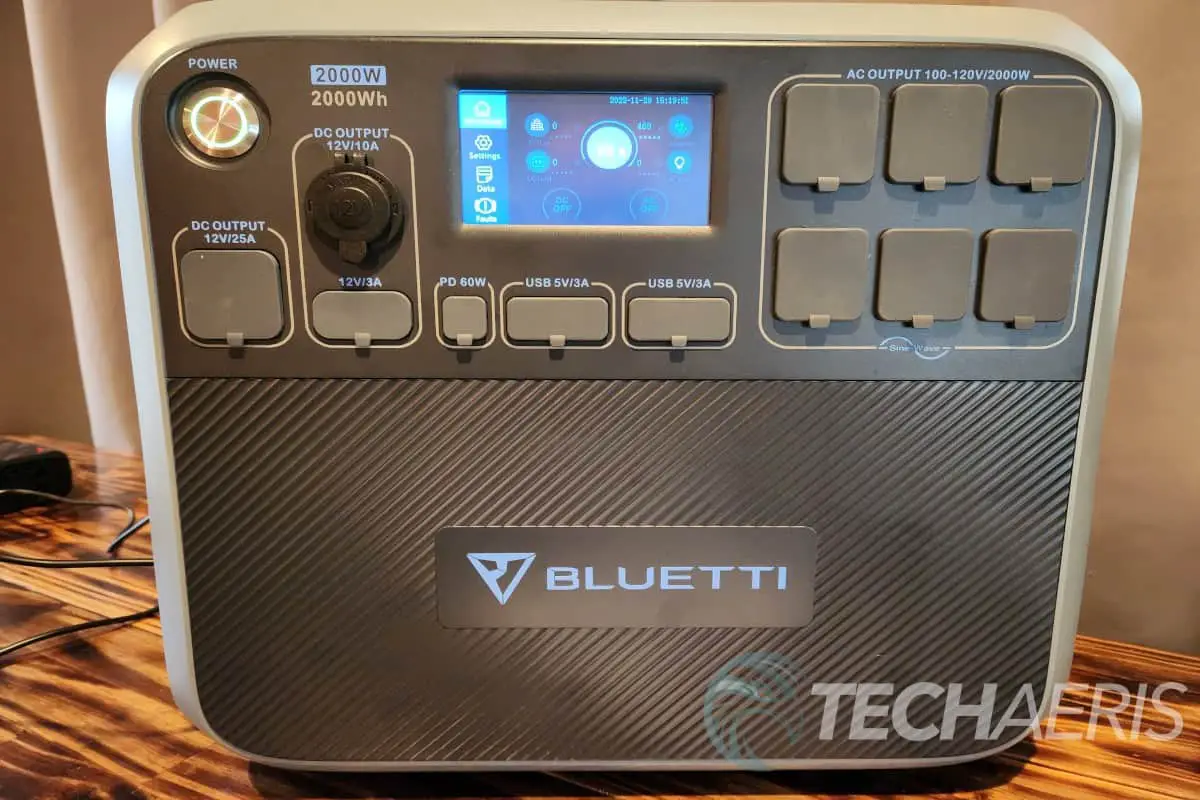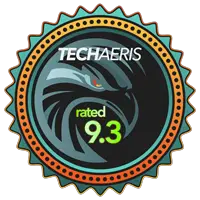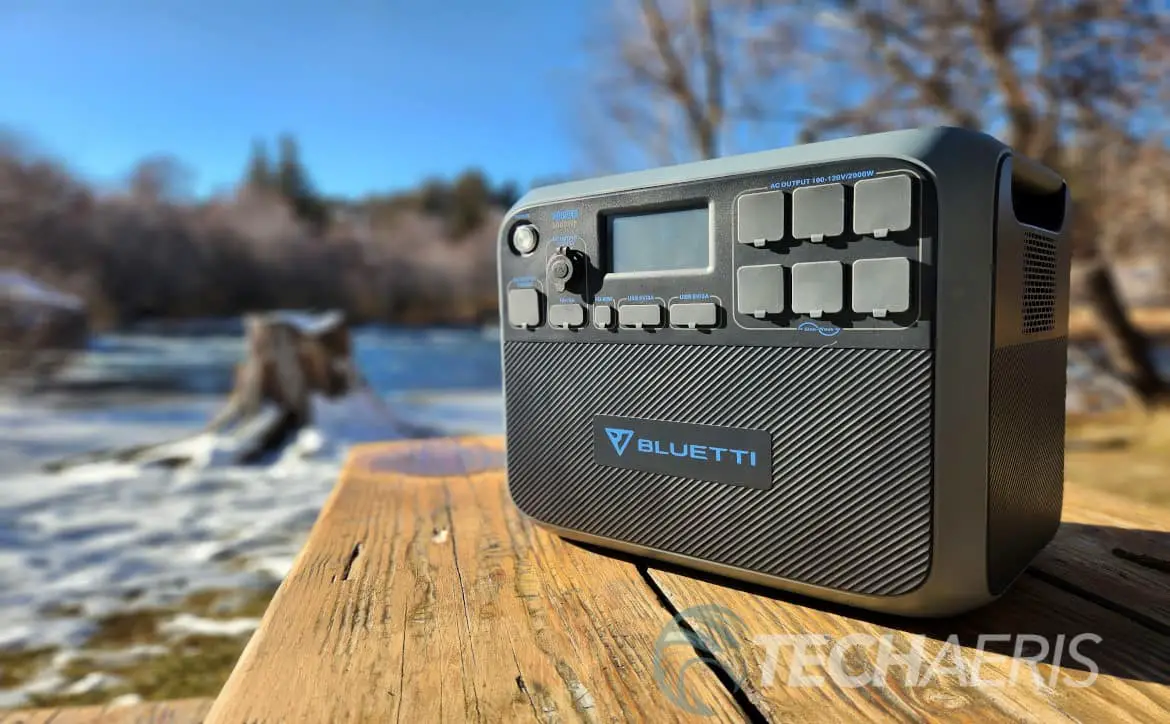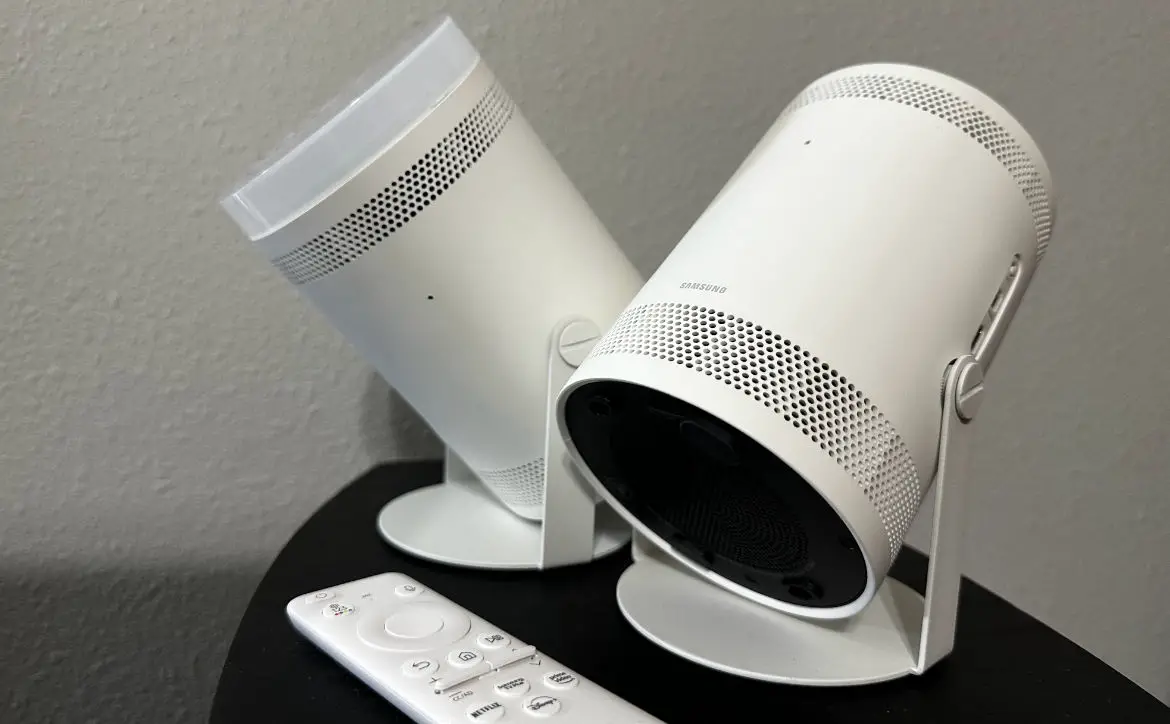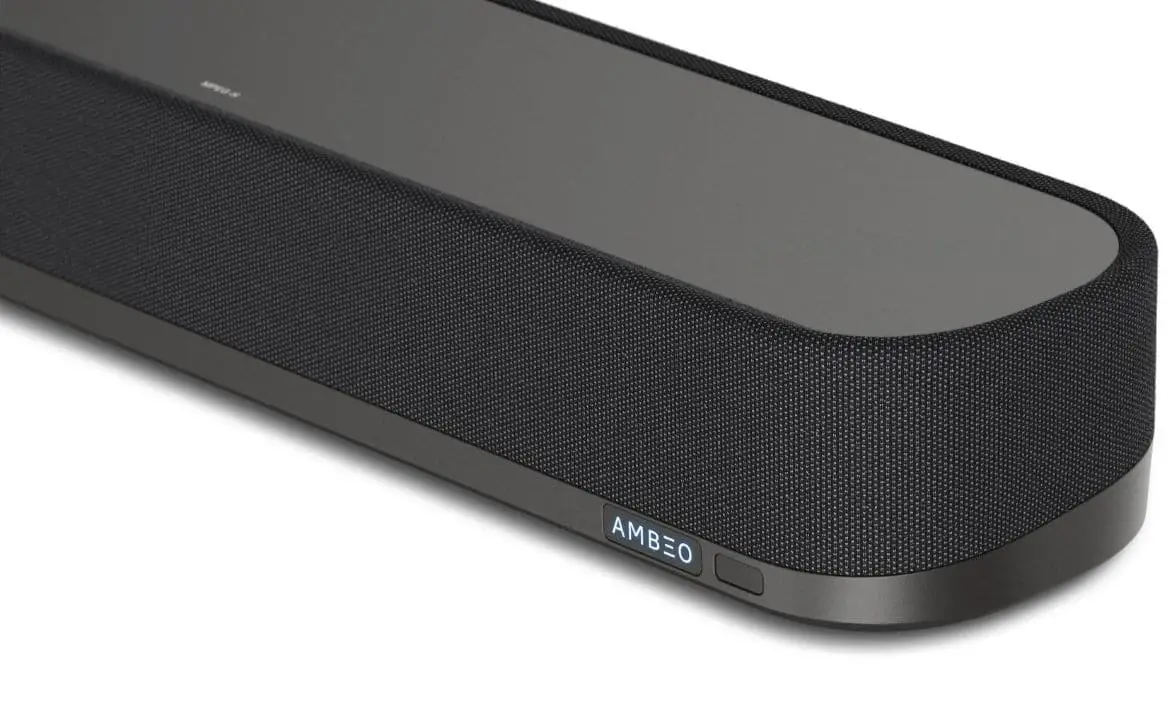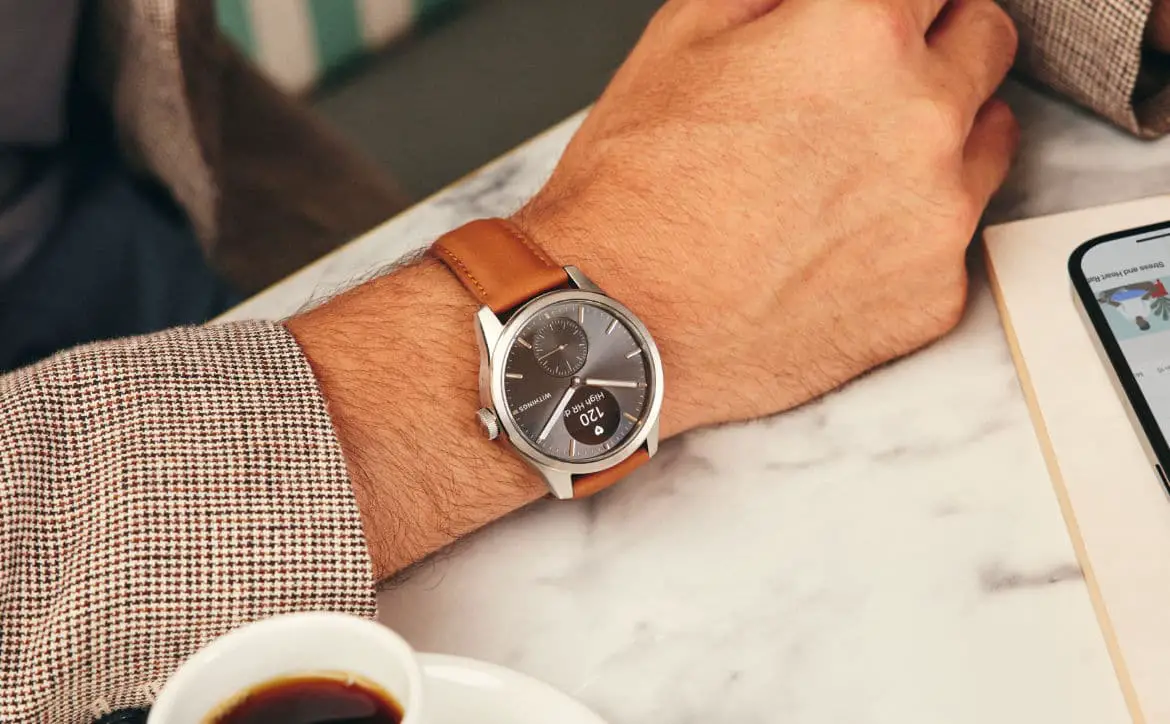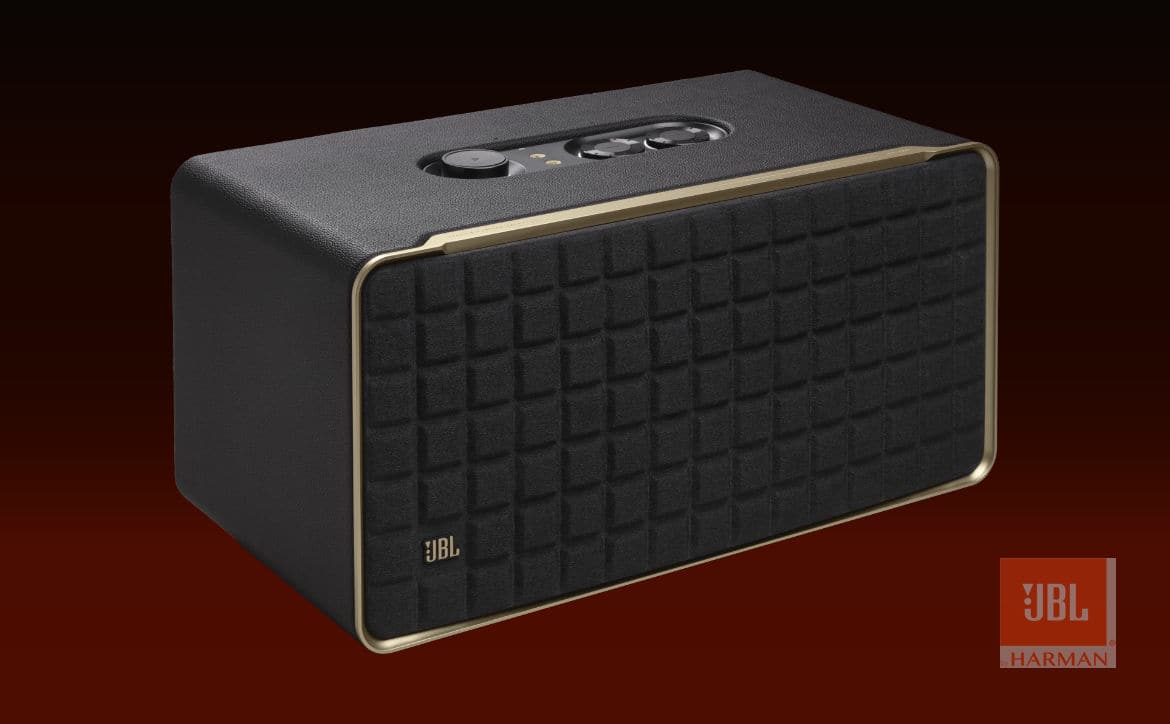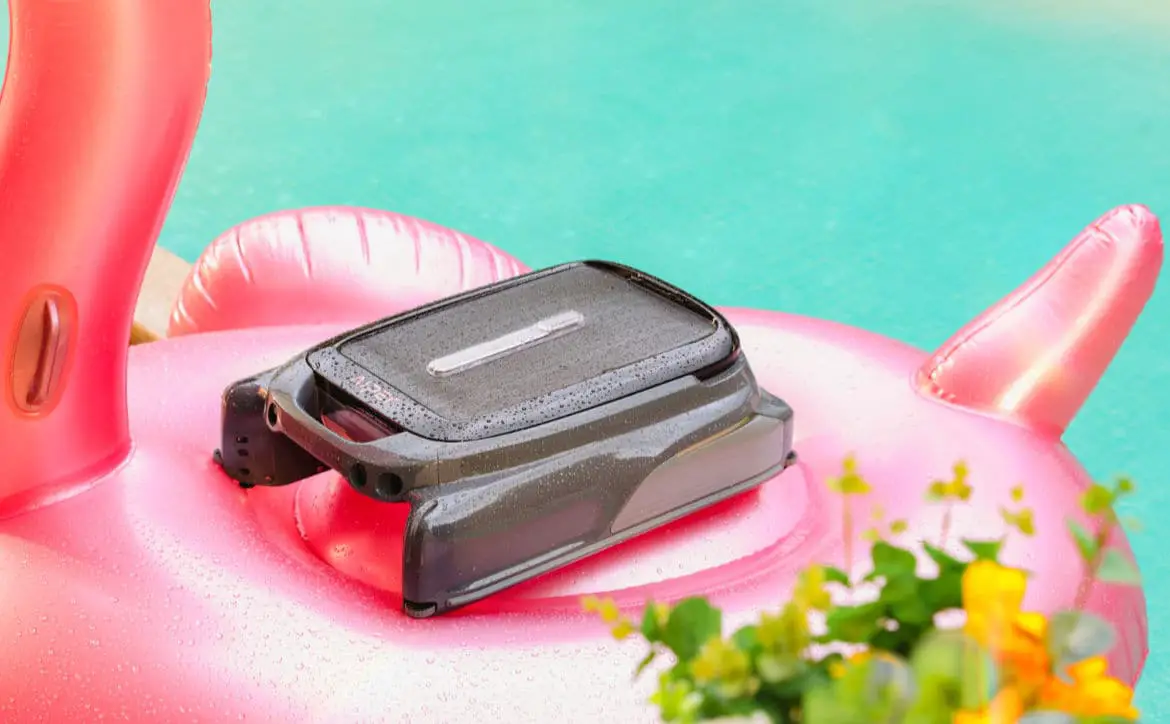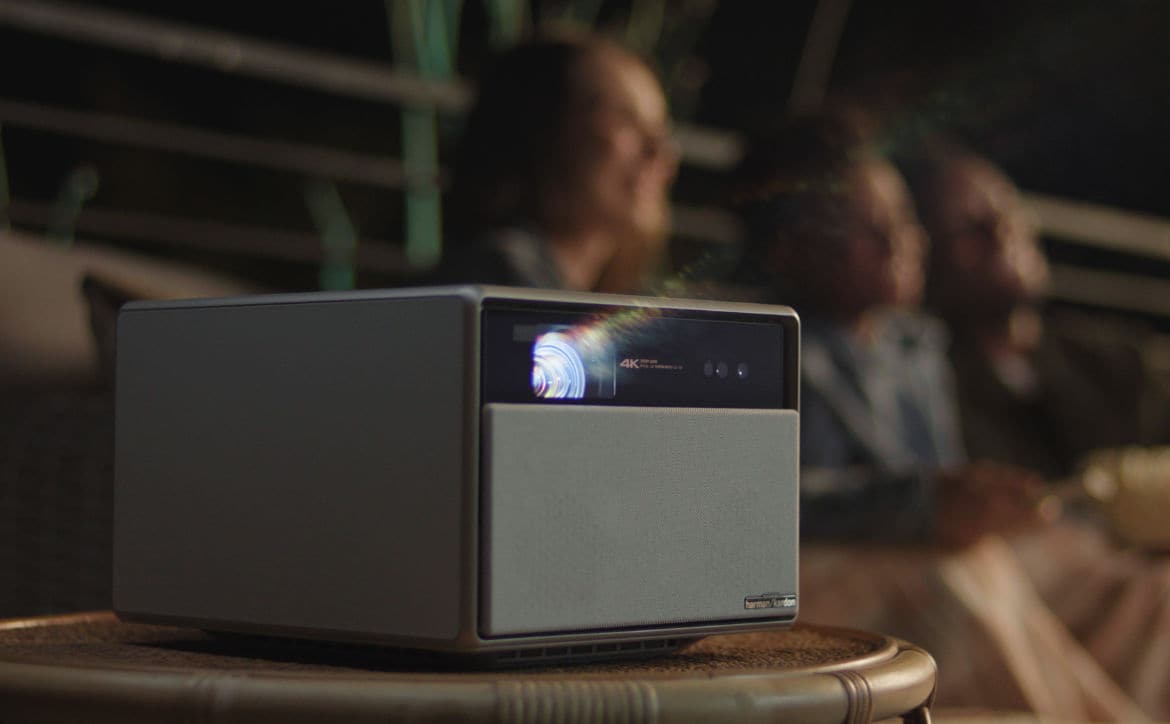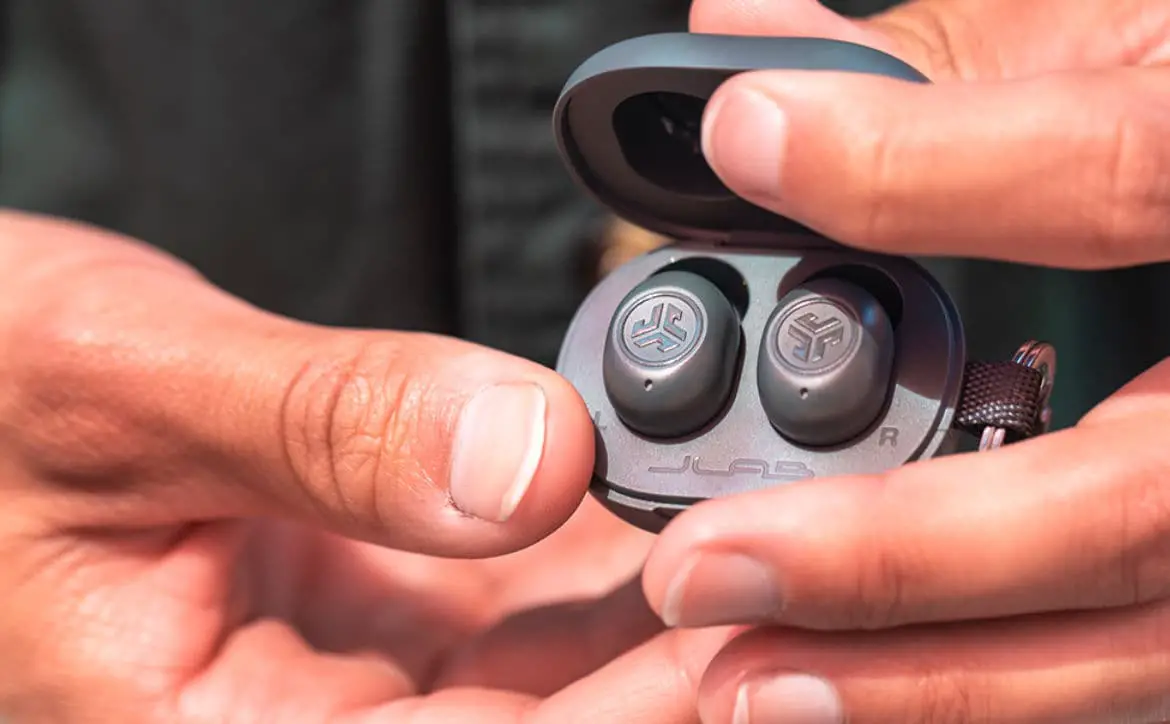
Back in August, I took the BLUETTI EB3A on a road trip through two national parks and five states. It traveled very well and did everything we needed it to do at the time. The EB3A is the smallest portable power offering from BLUETTI at 268Wh with a 600W inverter. BLUETTI offers a few other models that can be considered more portable. The smallest being the EB3A, followed by the EB55 at 537Wh, the EB70S at 716Wh, and the AC200P at 2,000Wh. The BLUETTI AC200P amps up the watts and the inverter and almost crosses the line between portable and stationary. Let’s get to the specs and give you a rundown of this monster portable power station.
Estimated reading time: 21 minutes
Table of contents
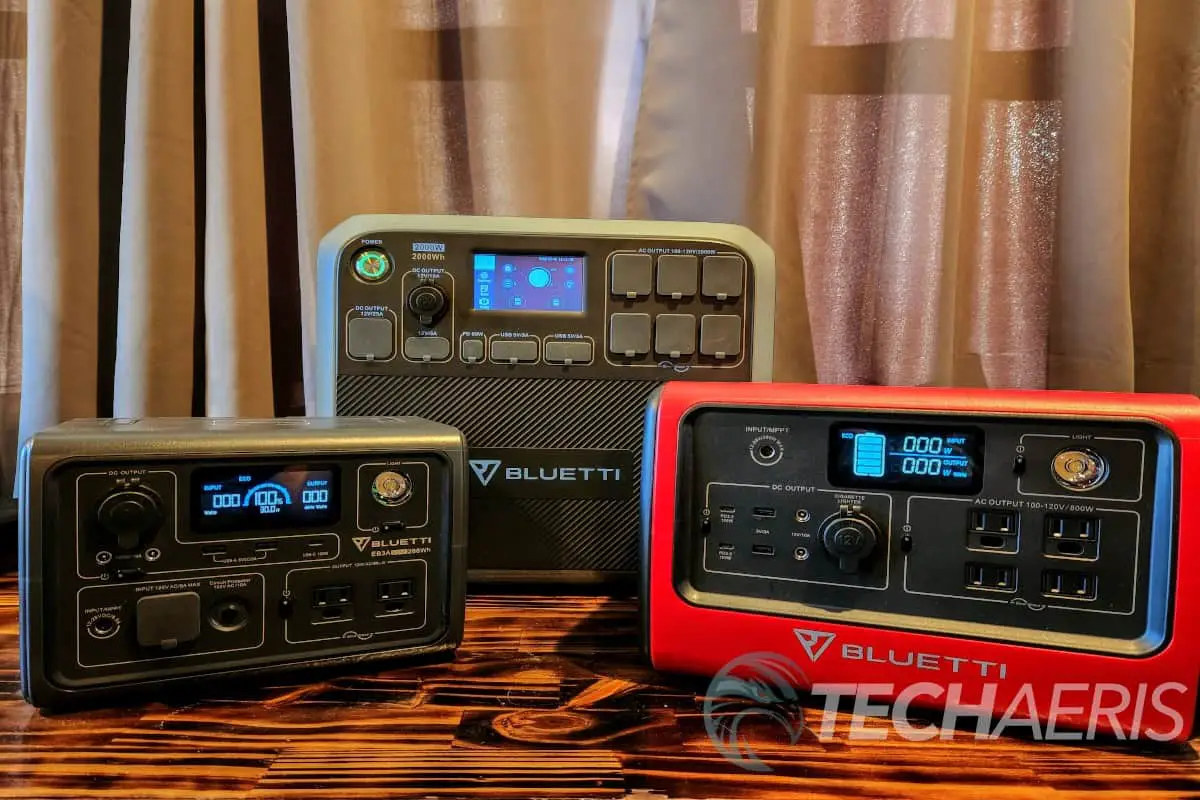
Specifications
Battery Info
- Battery Capacity: 2000Wh (50V,40A)
- Battery Type: LiFePO4 (Lithium Iron Phosphate)
- Life Cycles: 3,500+ Cycles to 80% Original Capacity
- Shelf-Life: Recharge to 80% Every 3-6 months
- Management System: MPPT Controller, BMS, etc.
Outputs
- AC Outlets: Pure Sine Wave Inverter powers 6 x 120V/20A Receptacles, 2,000W In Total
- 12V* DC Outlets: 1 x 12V/25A (RV Outlet)
1 x 12V/10A (Car Outlet)
2 x 12V/3A (5.5mm Outlet)
*All Regulated. - USB-A Port: 4 x 5V/3A
- USB-C Port: 1 x 60W Max.
- Wireless Charging Pad: 2 x 15W Max.
Inputs
- AC Adapter Input: 400W Max.
- Solar Input: 700W Max., VOC 35-150V, 12A.
- Car Input: 12/24V from Cigarette Lighter Port
- Maximum Input: 1100W, with AC and Solar Input Simultaneously
Recharge Times:
- AC Adapter (400W): ≈5.5~6 Hours
- Solar (700W): ≈3.5~4 Hours (With prime sunshine, ideal orientation, and low temperature)
- 12V/24V Car Outlet (100W/200W): ≈10 or 20 Hours
- AC + Solar (1100W): ≈2.3~2.8 Hours (With prime sunshine, ideal orientation, and low temperature)
- Solar + Solar (1200W): ≈2.1~2.5 Hours (With Optional D050S DC Charging Enhancer)
- Dual AC (800W): ≈3~3.5 Hours (With Optional Dual Adapters)
General:
- Weight: 60.6 lbs
- Dimensions (LxWxD): 16.5 x 11 x 15.2 in
- Operating Charge Temperature: 32-104℉
- Operating Discharge Temperature: -4-104℉
- Storage Temperature: -4-104℉
- Warranty: 48 Months
- Passthrough Charging: Yes
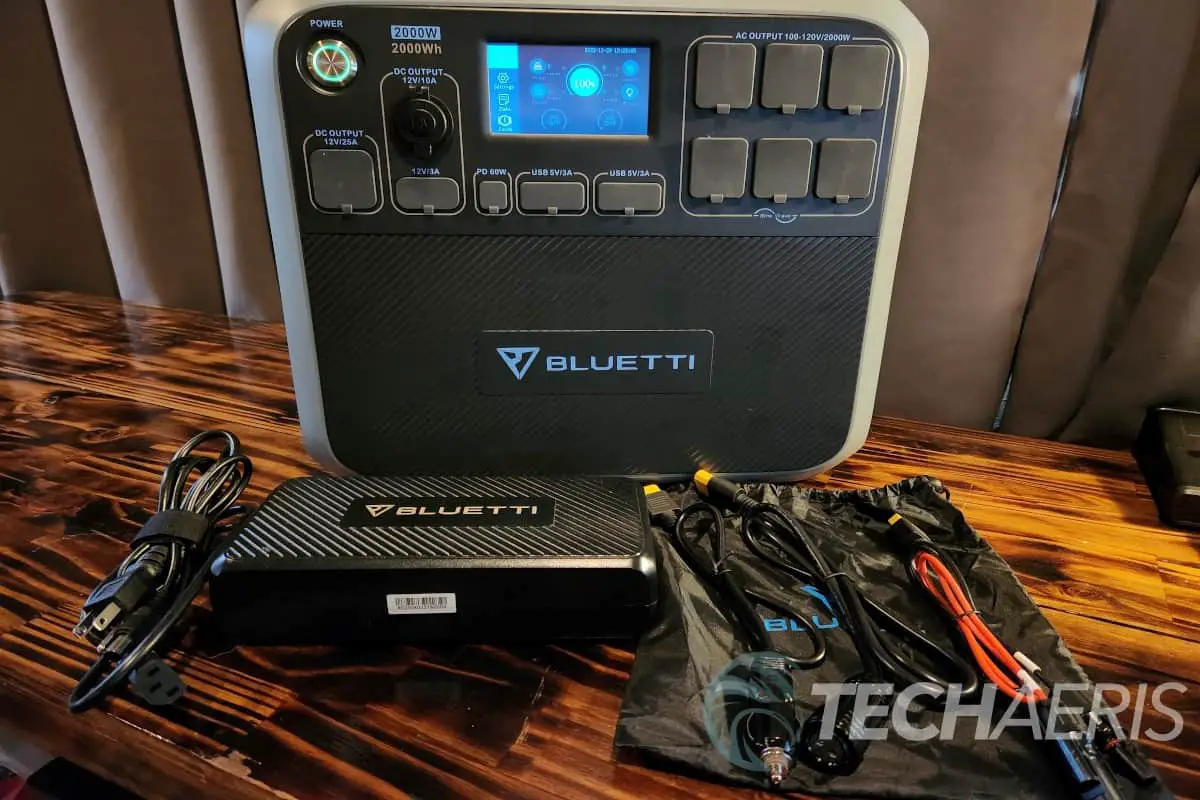
What’s in the Box
- BLUETTI AC200P Power Station
- AC Adapter
- MC4 Solar Charging Cable (MC4 to XT90)
- Car Charging Cable (Car to XT90)
- XT90 to Aviation Plug (Input Cable)
- User Manual, Warranty Card and Certificate
Design
The BLUETTI AC200P is targeted as a portable power station but is borderline a stationary unit. Weighing in at 60.6 pounds makes it less grab-and-go than the EB3A or even the larger EB70S. BLUETTI took its size and weight into account with their design of the outer shell though by placing two very sturdy hand holds on either side of the unit. They leave adequate room for any size hand to get inside and have textured the inside of the handles to help secure your grip. I would have liked to have a little rubber or something grippy, but the texture and size of the handles are plenty and very sturdy. I wouldn’t want a flip-up handle on something this large and heavy.
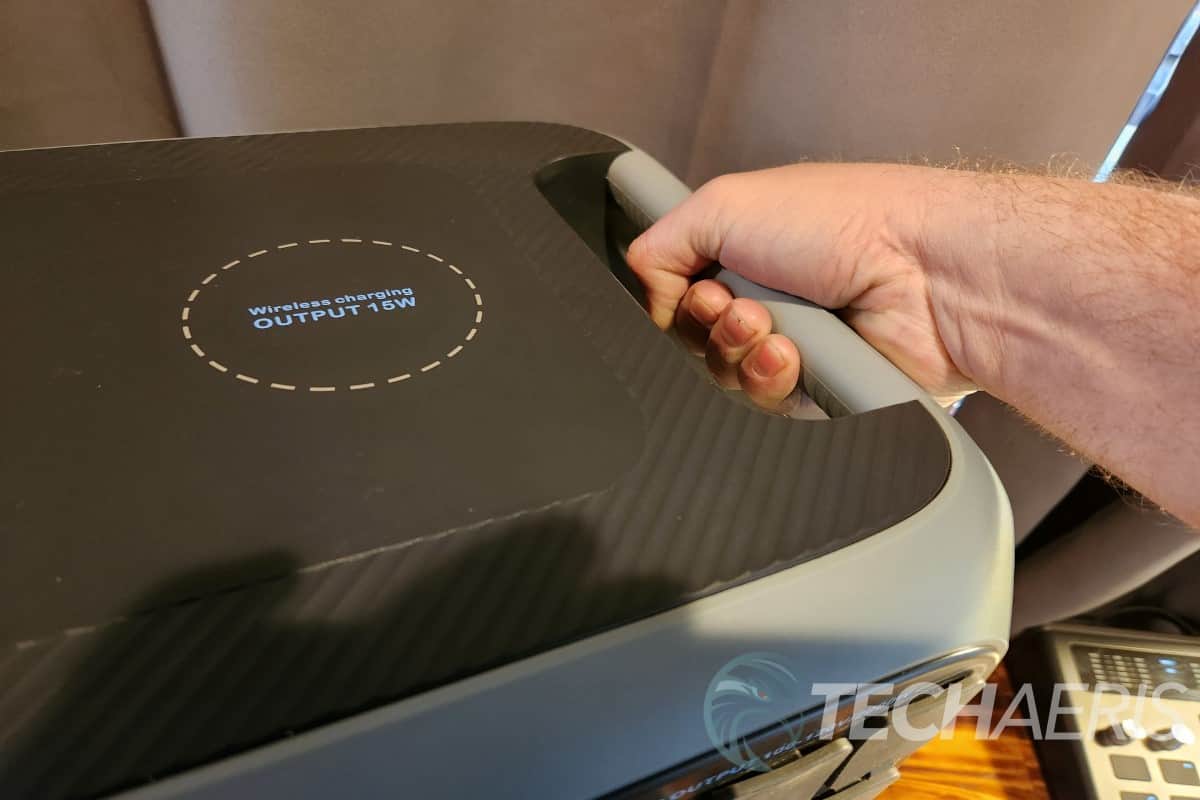
Across the top, you find two wireless charging pads for your smartphones. They are much larger pads than you find on the EB3A or EB70S, and you can hit the sweet spot with very minimal effort.
Along the front is where you find the business end of the BLUETTI AC200P. Starting on the left side, you will find your physical power button. It is recessed to help prevent accidental presses, but the button also depresses into the unit to turn it on and off. When the unit is on, a green light ring circles the button.
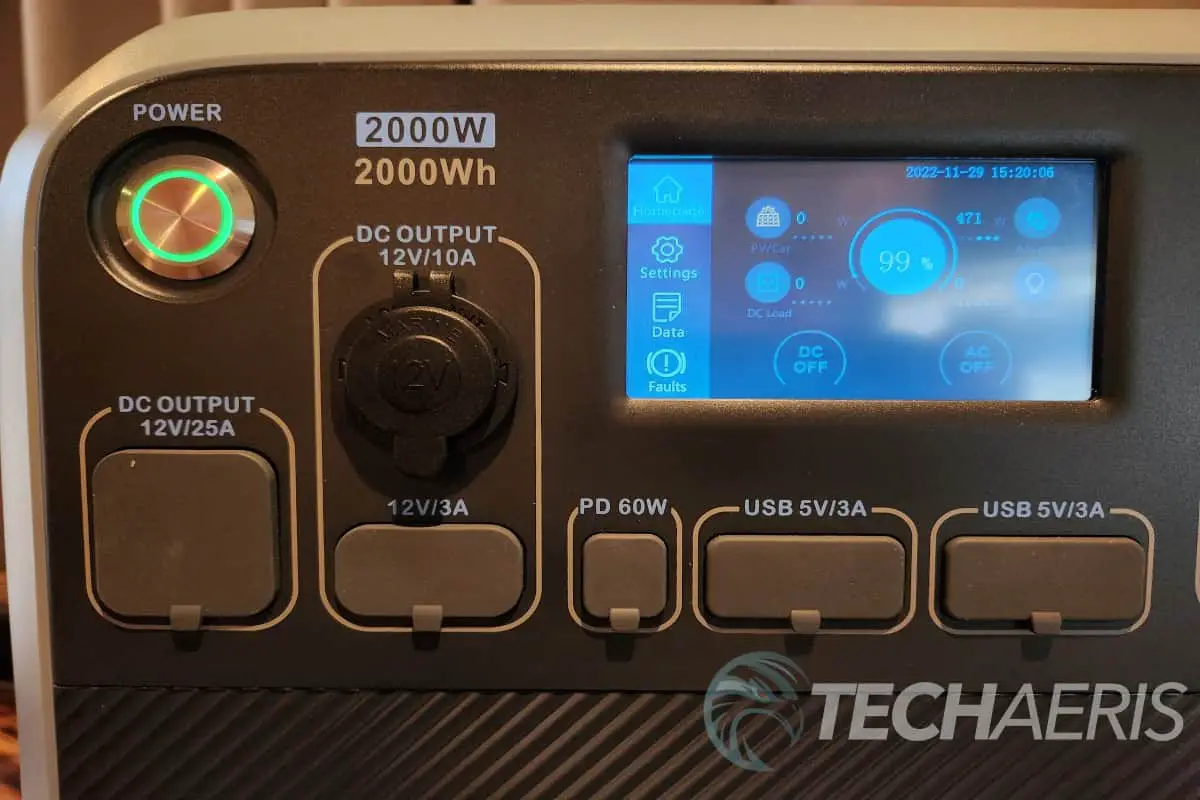
Below the power button is your first output port. It is a 12V/25A DC Aviator plug.
To the right of that plug is your standard DC 12V/10A Car plug and a pair of DC 12V/3A barrel plugs. Continuing to the right we come to a power delivery port (PD) or USB-C, rated at 60W. Next is a set of 2 USB 5V/3A plugs, giving you 4 USB plugs.
The final set of output connections are six 100-120V three-prong AC plugs attached to the 2000-watt pure-sine wave inverter.
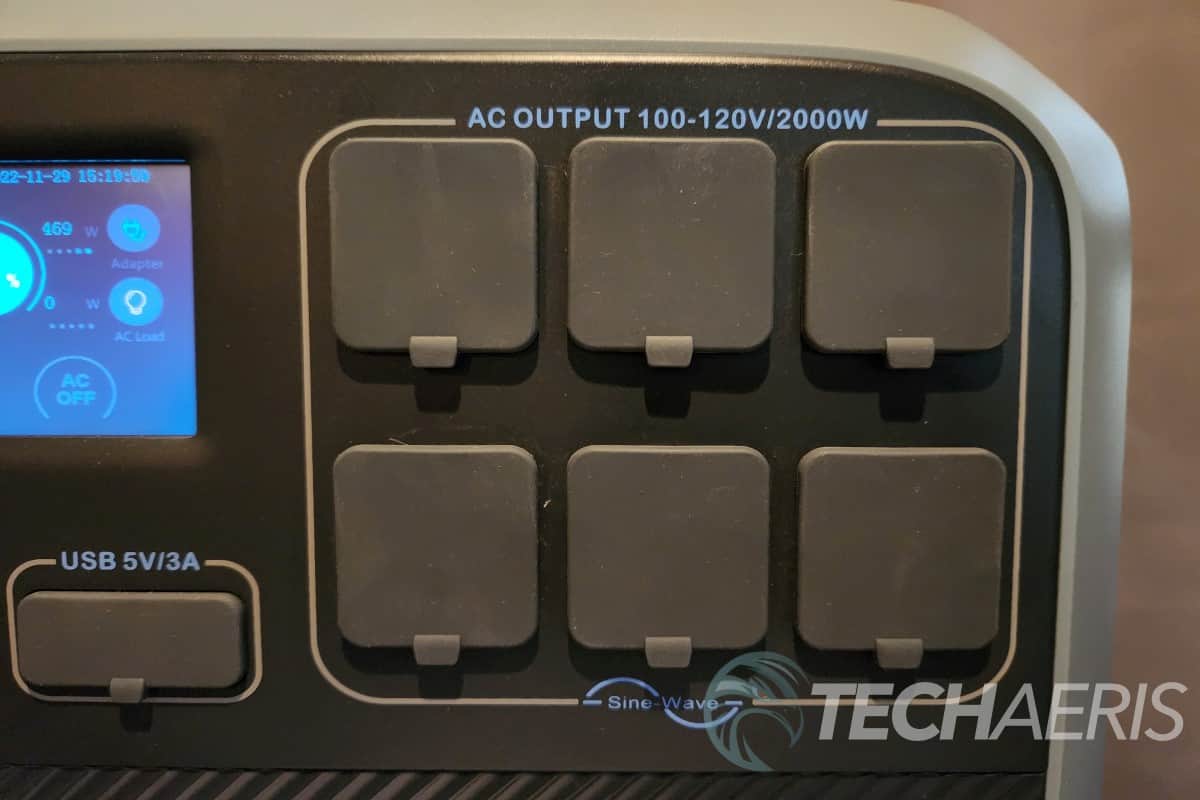
All of the output plugs on the front of the BLUETTI AC200P are covered by easy-access rubber covers to help keep dust, dirt, and other objects from finding their way inside.
The LCD touchscreen sits to the left of the AC plugs and is surrounded by the rest of the output ports. It measures in at 4.25in diagonally, giving you plenty of screen space. On very bright days, the screen was a little challenging to see, but not impossible. We will dive into the software and what the screen shows you in just a little bit.
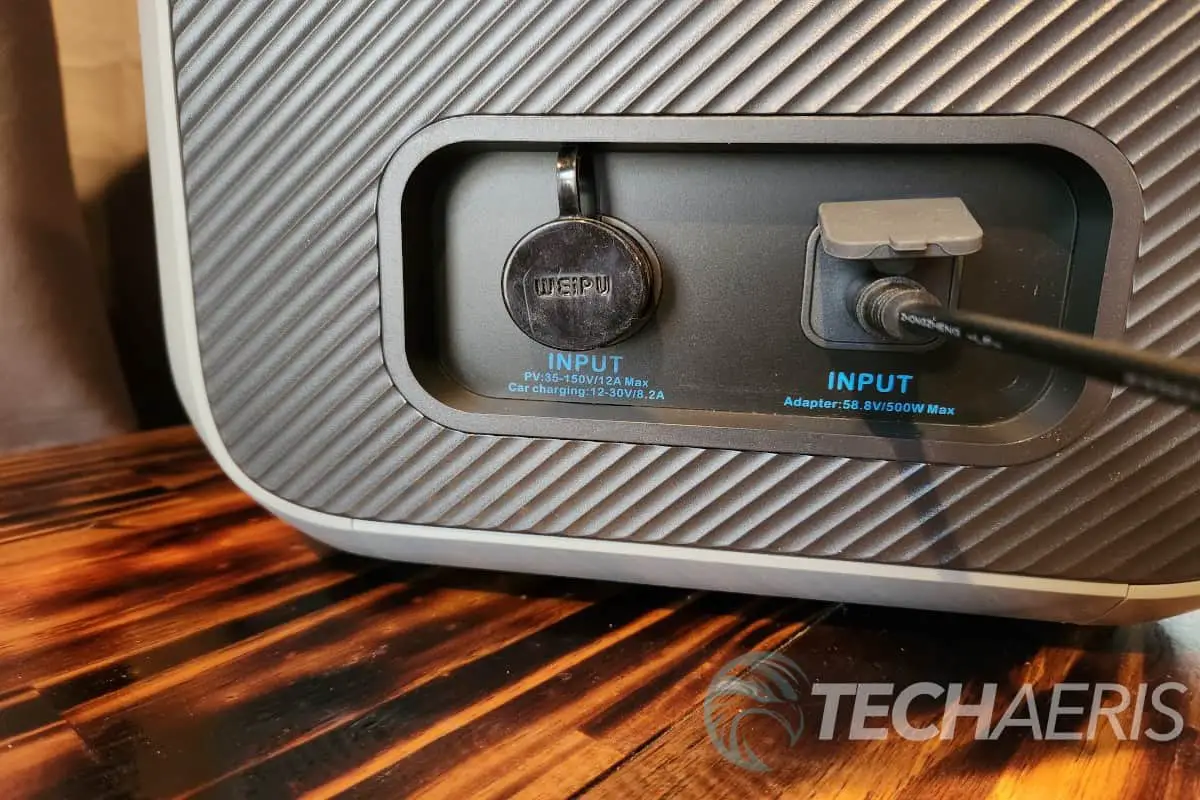
Only two other ports are found on the AC200P, and they can be found on the left side of the unit at the bottom. One is the aviation plug. This plug is for use with your solar panels and your car charger. The other is an AC input barrel plug. Again, both are covered by rubber plugs to protect them.
The bottom of the unit has four large rubber feet for stability and surface protection. The only other notable exterior design components are the fans located on either side under your handles for cooling.
Ease of Use
Like all the other power stations, the basic use is pretty straightforward. You push the aluminum power button to turn it on, connect your electrical gadgets to the device, and go about your day. The physical recessed power button is a nice design choice, in my opinion. Many of the other units we have looked at all have a basic button that requires you to long hold, and those can sometimes be pressed inadvertently while traveling or moving them around.
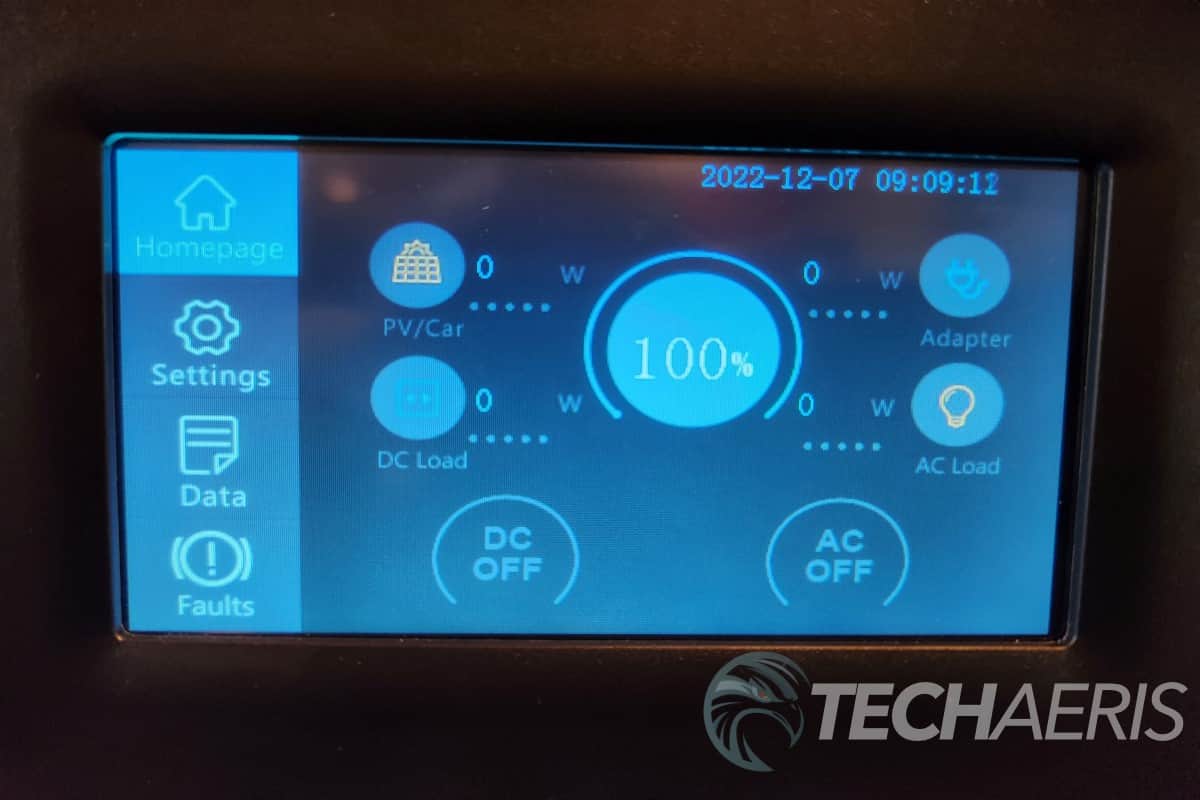
The screen on the front is where you will find all the information about the unit. There are some pros and some cons to how BLUETTI laid out the information. In the center is your charge percentage, both in digits and represented by a bar that circles it. To the left, you will see the PV/Car (solar and car) input information and your DC output loads. On the right, you see your AC input information as well as your AC output load. Below that, you have your AC and DC on and off functions. When you touch one of the output options, a pop-up window appears so you can power that function on or off. It ensures you are meant to turn it on or off.
On the left-hand side, you have a series of icons that run vertically down the screen. The first is the Homepage, which is the main screen the unit starts up and displays. Next, you will see a cog for the settings menu. In settings, you will find a few things of interest. For the first two, I don’t suggest you change them unless you have a specific need to alter them. The first one is changing the AC Output Voltage to 100vc, and the second is changing the output frequency to 50Hz.
The next two will be your toggle from Car to PV and Eco Mode. The toggle for the car to PV will be necessary as they both charge differently. Under PV mode, you need the panels to be putting out more than 35V of power and less than 150V to get the AC200P to accept the power and charge the batteries. Switching to Car mode puts you at 12V – 30V.
The Eco mode option is designed to let you retain as much power as possible. With it on, the AC200P will shut down after 4 hours if the load is under 50W. If you leave Eco mode off, it will remain on no matter how small the load, even if there isn’t one. For instance, I have a small DC fan that draws 5w of power. With Eco mode on, it will shut the unit off in 4 hours; with it off, it will stay on. Keeping it on, so my fan never turns off is ideal in most situations for myself. You’d probably want to turn it off if you were running a small fridge that may not need to draw a lot overnight, so the fridge has power when it needs it.
BLUETTI AC200P Video Overview
On the setting page of the settings screen, you get general options consisting of language, buzzer, date, and time. The buzzer is for an audible alert about any faults the unit may encounter.
Under the next icon, you get Data. Inside that menu, you will find basic product info such as the BMS, ARM, DSP, and HMI. Next is the Inverter&Charger info. This menu lets you dig a little deeper into the system by letting you look at input voltage, current, power, and energy generated on the PV/Car option. The adapter charge gives similar details. Under DC Output, you get a readout of all the various DC output ports on the BLUETTI AC200P. It displays total output Volts and Watts and breaks it down by each plug. Under the AC output menu, you get a total Voltage, Current, Watts, and Frequency display.
If you go back to a screen, you can go into BMS (Battery Management System) Maintenance. Here you will see the Battery Voltage, Battery Current, Battery SOC%, and BMS State.
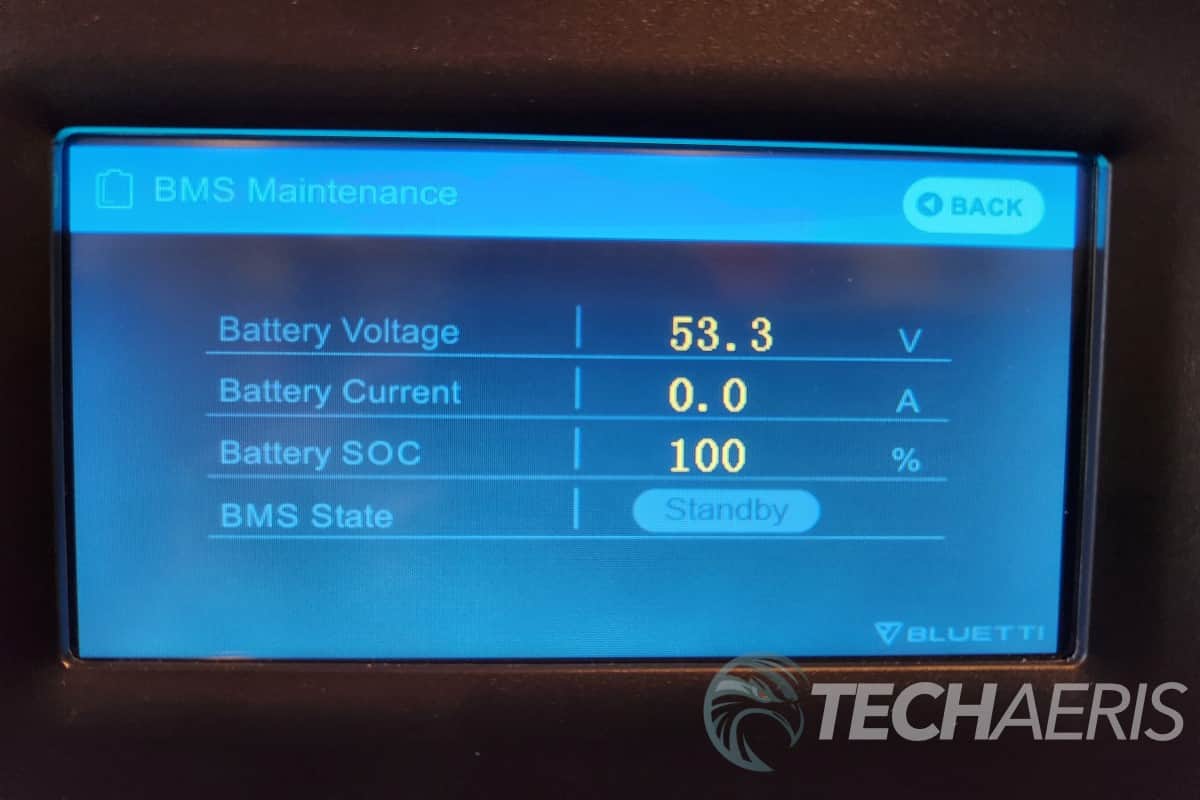
The Fault History screen is the last screen under the Data menu. This is where you will find any faults that the unit has thrown that caused it to shut down or stop working with a particular input or output device. Once you have fixed them, you can clear the list so you don’t see old faults.
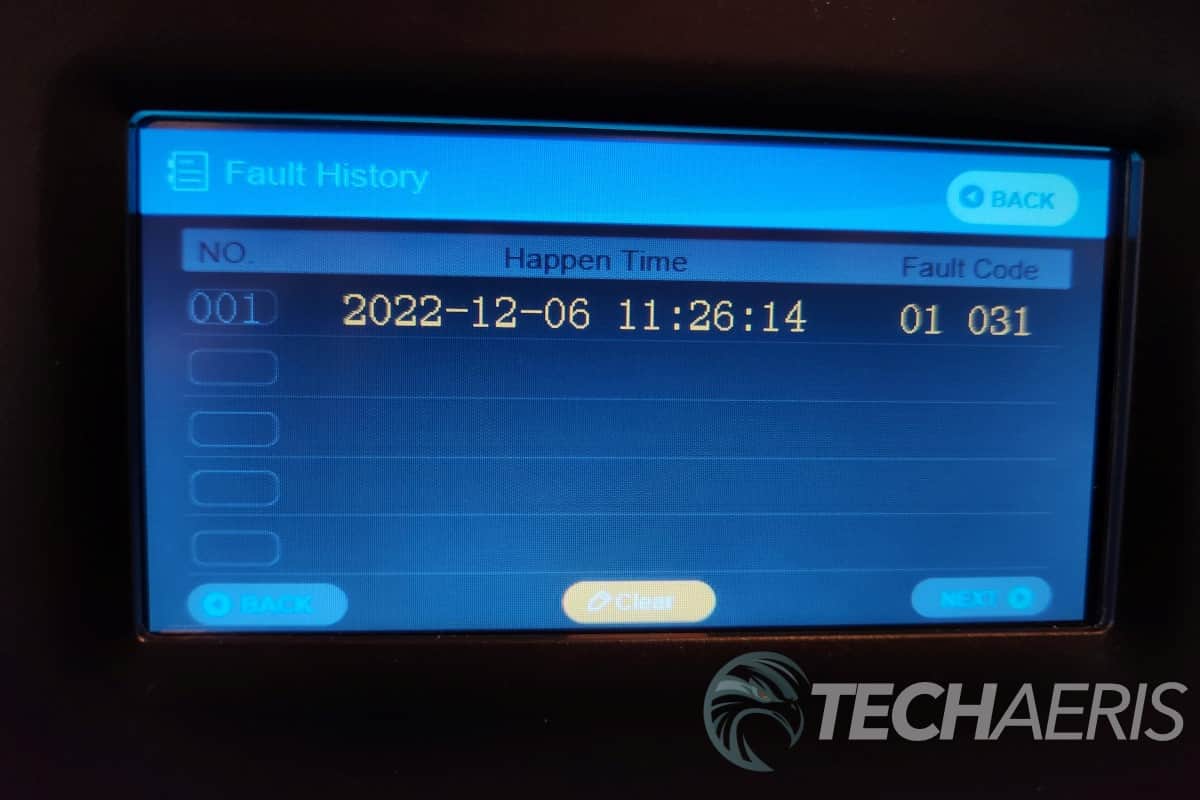
The last option available is the Faults menu. This is not the same as the Fault History screen above. The Faults menu is a 6-page readout (55 total faults) of all the various faults the AC200P could through at you and their corresponding numbers. It beats the heck out of getting a 001 fault and having to hop online and search. That one is PV/CAR Over Voltage, by the way.
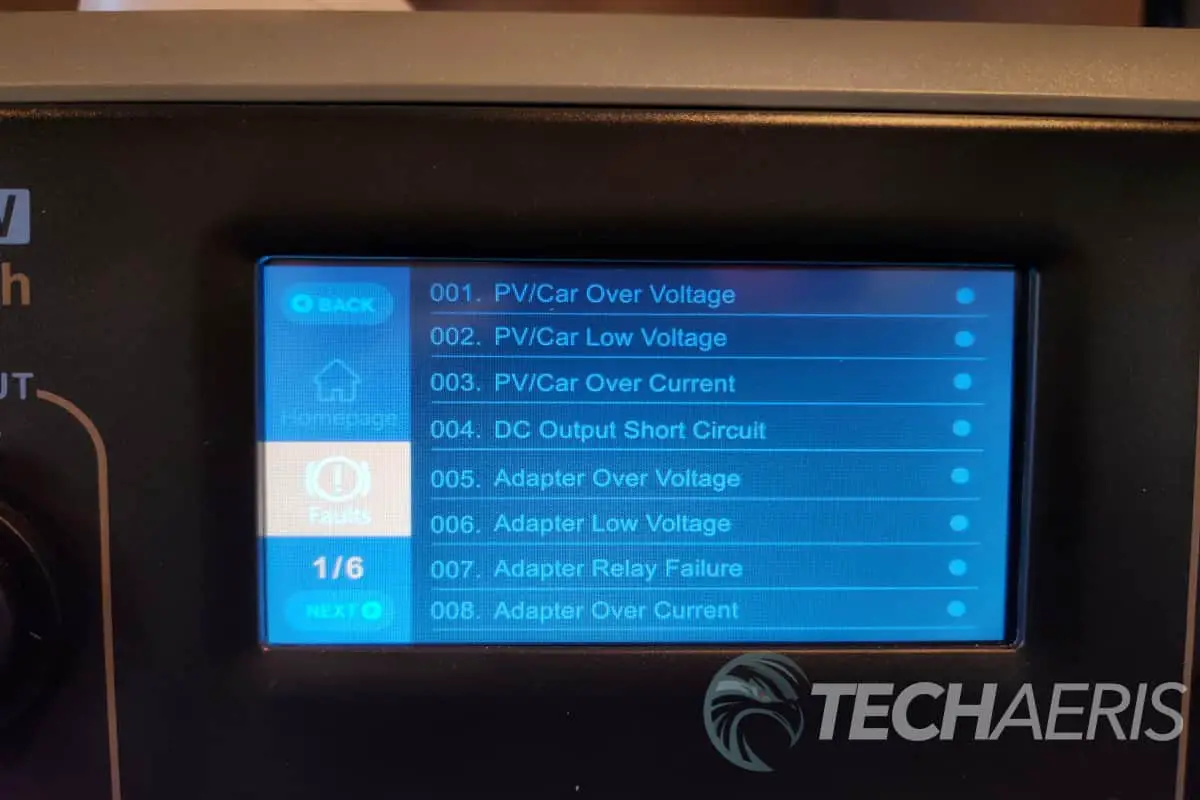
Many of the screens you find in the menu are accessed by simply tapping each corresponding icon on the home screen. i.e., tap on the AC Load icon, and it will take you to the same AC Output screen that you arrive at going through the Data menu.
Connecting external power is as simple as plugging in your laptop. The large power brick has a barrel plug that plugs right into the side of the AC200P. The connection some may have a little trouble with is the PV/CAR plug that uses the Aviation connection or RV connection, as I have seen it called also. This two-prong connection connects like an air hose attachment. You pull the ring back slightly as you slide it on, and it clicks on. A pretty small red dot on the plug and connector must be lined up for the plug to go into place. If it’s dark, spin the plug until it slides on without any force.
Overall the ABLUETTI AC200P is pretty straightforward and easy to use. There are a lot of settings and options built into the system that most users won’t ever look at though. The touch screen is plenty responsive, even for fat fingers like mine. The lack of a visual estimated charge/discharge readout does hurt the ease of use, as your math skill will come into play a lot more often.
Performance
Providing specific performance information for my needs and the devices I used can leave some things up in the air for some of you. My laptop might pull more power than yours, or maybe less. The kitchen gadgets and power tools I ran might have different ratings than yours. The amount of time I could run my TV on a full charge might be different than your TV. At the end of the day, the performance information is just my experience. A good mathematical estimation of working time, as provided by BLUETTI, is 2000Wh * 0.90 / operating power of your device. (0.90=Conversion Rate). To put that into practice, 2000Wh * 0.90 = 1700Wh / 175W = 9.71 hours. The 175W represents the total power drawn from whatever might be plugged in and consuming battery power.
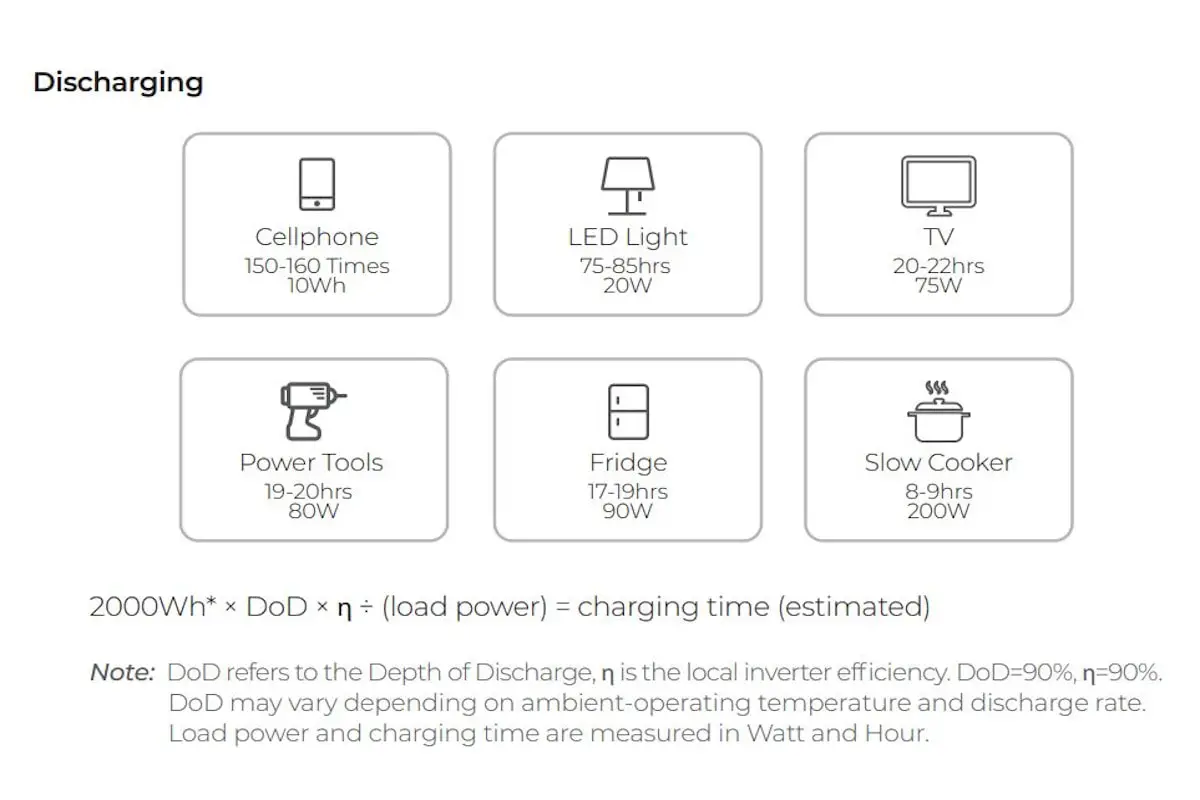
I’ll go into a little detail on some of the devices I connected and operated with the BLUETTI AC200P, but first, let’s talk a little bit about my experience with idle times. Those will be the times when I didn’t have any input or output draws on the unit. It was just powered on.
From a full charge of 100%, I left the AC200P on for 8 hours and only lost 2% power leaving the box at 98%. Next, I turned the AC power on. That will have a higher draw as it should turn the inverter on. Over 2 hours, it dropped by 3%. If it stays consistent, I would expect a 12% drop over 8 hours. I switched the DC power on while leaving the AC powered on before I went to sleep. Throughout the night, it dropped 11%, which was over the course of 7 hours. With the Eco mode turned on, the unit shut off after 4 hours as intended with no loads.
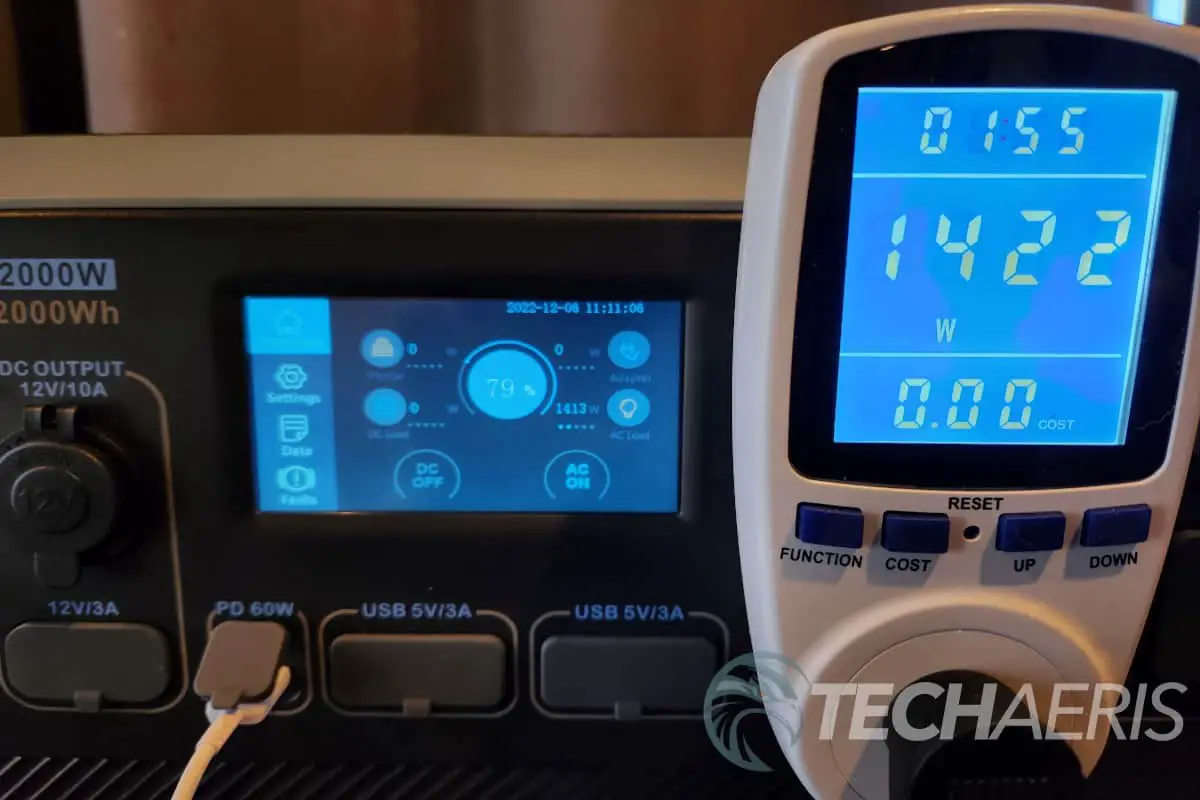
Anything under the rated 2,000w rated inverter ran without issues. I cooked up some rice with the rice cooker. I made some fries and pizza rolls in the air fryer (1375W). I simultaneously charged my phone, Samsung watch, laptop, headphones, and a few other small electronics. I hooked up the jigsaw (250W), made some cuts with a Skill saw (1318W), and then sanded the wood down with a palm sander (140W). I ran our electric fireplace for about 30 minutes on high (1422W).
The only limit to what the BLUETTI AC200P can run will be determined by the watts that the device/devices you connect to it needs. Being that most of us will use a unit like this to make it through a power outage or for basic needs while camping, ect, it offers more than enough power.
I try to push these little units past their rated output watts to see if the basic safety mechanisms work. To push the AC200P, I ran the heater on high and connected the hair dryer. The heater was pulling 1422w. I turned the hair dryer on low air and low heat and hit around 2,222w.
The fault icon popped up for inverter overload. I cranked the hair dryer to the max and spiked it to 2800w before the AC output turned off. BLUETTI does list that the AC200P will take a 4,800W surge on the inverter, and all my research states it can handle it for about 2 minutes to protect the internal components. This was a continuous load, so it shut itself off to protect the electronics.
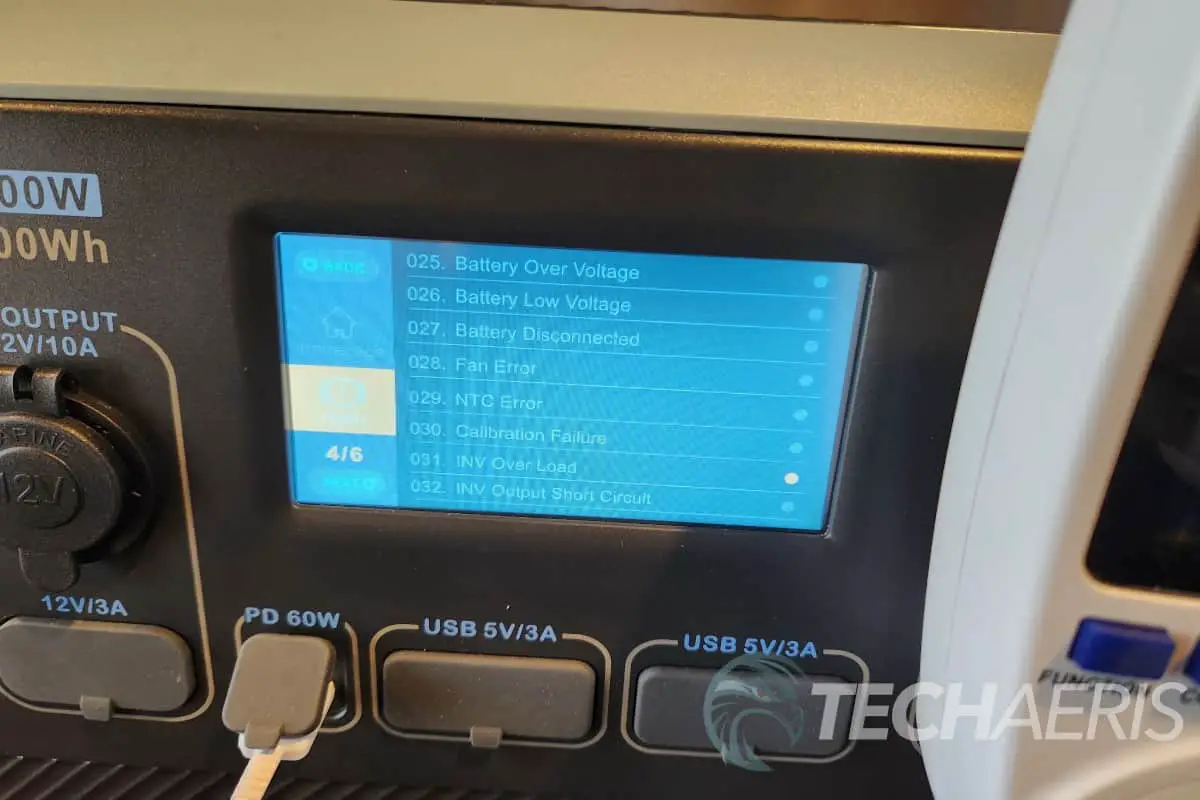
Spec-wise, BLUETTI states the AC200P can take 400W of input from the AC power block. I was consistently getting around 450W of input charge with some spikes to 469W. The watt meter showed I was pulling between 514W and 533Watts.
At a 450W average, a full charge from 0% would take roughly 4.5 hours. That is shorter than what BLUETTI lists at 5.5~6 hours. I ran the AC200P from full 100% to 0% and back three times and was able to charge it completely in 4 hours and 20 minutes, give or take. This was with no additional input or output running on the unit.
I didn’t have any 20-hour road trips planned to see about vehicle charge times. With the output on a 12V system, your basic car/cigarette lighter plug being 100 watts-ish, it isn’t very efficient to use a 12v system as the primary means of charging, but pulling in some power will be better than no power.
I was unable to test out the solar charge rates due to the lack of sun and lack of adequate panels currently available to me. However, a max charge rate of 700W would certainly charge the AC200P up much faster than the standard AC connection. I would set up a 900W array to get you closer to the 700W max input since you typically see a 25% loss in actual output. You can always over-panel the wattage, just not the voltage. Being that the system can run between 35-150v, you could push more watts quite easily and have better results.
Your fastest out-of-the-box charge options would be using the AC adapter and running a full solar connection. That would get you in the 1,100W range, but more likely, 1,142W since the AC Adapter is pushing a little more. To maximize your charge, you can always pick up the additional D050S DC Charge Enhancer for $199 and run another 500W of solar to get you to 1200W. All of that is under absolutely perfect solar conditions.
While portable power stations are dramatically quieter than gas generators, some audible noise can be worrisome for some out there. Most of the time, a unit like the AC200P is being used in a small RV, Van, trailer, or room where sound is noticed more. The loudest sounds from the unit come from two places. The charging brick that ships have an internal fan that never turns off when plugged into the wall.
It doesn’t matter if the AC200P is fully charged or not. I recorded 33-40dBs on the adapter. This noise can be mitigated if you pick up the smaller T400 (400W) charging brick from BLUETTI that doesn’t need an internal fan. The fans inside the AC200P were nearly unnoticeable until I started putting heavy 2,000W loads on the unit.
When I had the heater going and charging a few other devices, I registered 55 dB on average from about 2 feet away. All the sound tests were with a dB app on my Samsung Galaxy S22+. A dedicated sound test device may produce different results, but at the end of the day, it is a fairly quiet unit when it isn’t plugged into the wall.
UPS and passthrough charging are always hot topics when it comes to these power stations. The AC200P does not offer a UPS function. Even some of the other products out there that offer UPS functions don’t flip over fast enough to be used as one. Most users advise buying a separate UPS designed to connect to your portable power stations to keep the flow of power going.
The AC200P does do passthrough charging as all the rest do. BLUETTI lists it as “Simultaneous Recharge & Discharge.” I ran a hair dryer while the AC200P was connected to the wall at full charge. It took a minute or two before the AC charge started to push into the unit. Since the AC charger can only push 442W, the 800+W output still resulted in the battery depleting as it was working.
Battery Life
Since the BLUETTI AC200P utilizes a Lithium-Iron Phosphate (LiFePO4) Battery chemistry, weexpect the battery life to be outstanding. BLUETTI places the battery life at 3,500+ complete cycles before the battery’s overall capacity diminishes to 80% of its original capacity.
That translates to the battery holding 1,600Wh versus the original 2,000Wh. Your 3,500 recharges puts you at 9.5 years if you charge and discharge it every day. A person could use the AC200P to power a tiny home, van, RV, etc., quite easily and could potentially be using it daily.
Your actual mileage on the battery’s life span may differ depending on how much you use and recharge it. I’ll be taking it out camping a few weekends a month during the summer and keeping it powered up for potential power outages. If the rest of the unit’s electronics last as long as the batteries, then I expect to have it for a very long time.
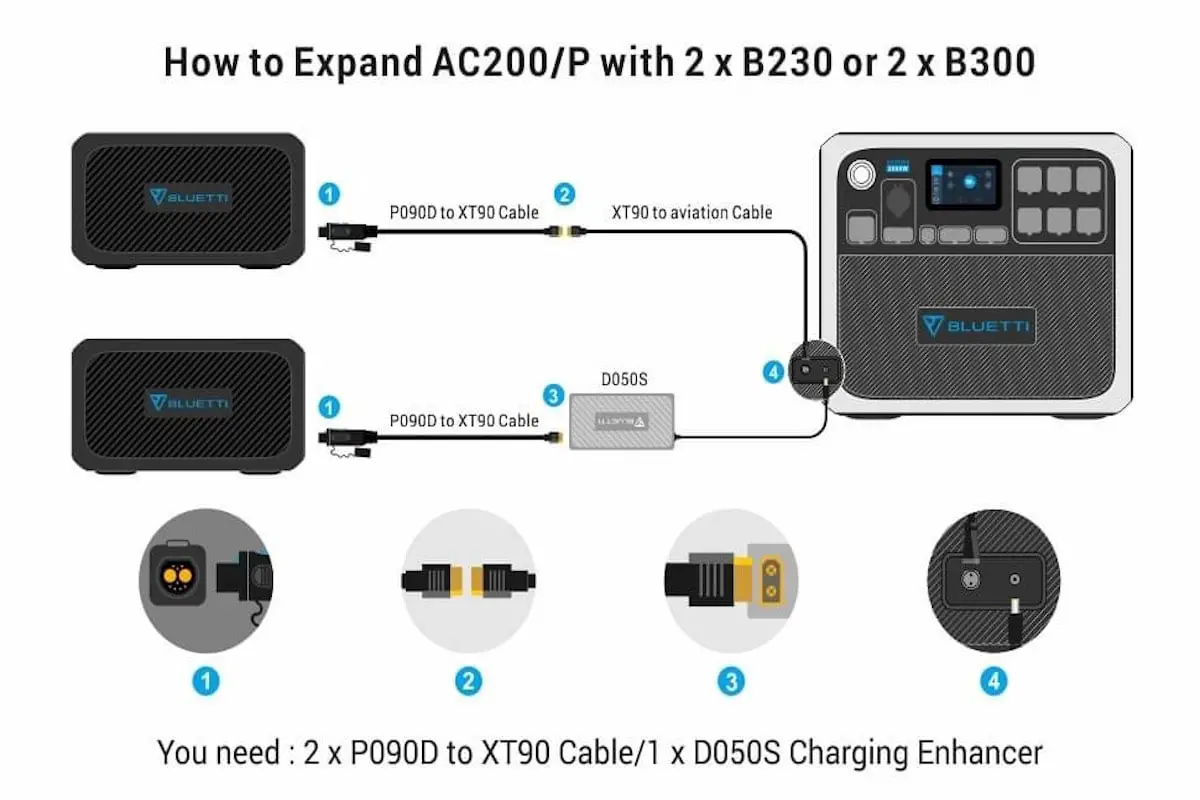
The AC200P has additional battery options available to it, just like the newer AC200Max. If the 2,000Wh isn’t enough, you can pick up a BLUETTI B230 Expansion Battery with an additional 2,048Wh for $1,399. If more power is needed, the BLUETTI B300 Expansion Battery is also an option. The B300 delivers 3,072Wh of power for $2,199.00.
If you add a battery expansion at your initial purchase, BLUETTI will include the cable needed to connect it to the AC200P. If you buy the expansion batteries separately, you will also buy the cabling. You are able to run two additional batteries, but they need to be the same model, i.e., you can’t run a B230 and B300. At least as far as the available information I was able to find. Each expandable battery brings another USB-C (PD) port, a USB-A port, and a standard car socket. Check each spec if you are thinking of adding either one to your order.
Price/Value
When you compare the 2,000Wh battery paired with a 2,000W inverter to other manufacturers, you only find a few suitable brands. The Jackery Explorer 2000 Pro is one option. It gets you a 2,160Wh battery and a 2,200W inverter, but it is a traditional Lithium-Ion battery system with a recharge life of 1,000 before it drops to 80% and is roughly $300 more.
EcoFlow offers the DELTA Max at 2,016Wh with a 2400W inverter. It uses a Lithium Nickel Cobalt Manganese Oxide battery chemistry that gives you 800 cycles to 80% capacity and runs the same retail price as the AC200p. There are quite a few other brands out there that are all producing a wide range of portable power stations. There is nothing wrong with any of those options, as they all do their jobs and perform well. Digging into the battery chemistry, features, and the design/placement of the ports are high on my personal list.
The BLUETTI AC200P is at the better end of the price range and with longer capable lasting batteries. All of them seem to be in the same ballpark for warranty options. BLUETTI gives the AC200P a 48-month (4-year) warranty. Jackery does a 5-year if purchased directly from their website but a standard 3-year if purchased elsewhere. The EcoFlow Delta Max is 36 months (3 years) also.
While reviewing the BLUETTI AC200P, I have seen a number of sales hit around the internet. The full retail cost is $1,699.00. BLUETTI and other retailers had it as low as $1,399.00. I expect it to go back up after the holidays, but with the recent release of the AC200Max, I don’t expect it to go back to $1699, but we will see what happens.
Wrap Up
Overall performance and physical build quality of the BLUETTI AC200P have been very good. It is a little larger and heavier than a few other 2,000W power stations on the market, but it offers more output ports and a LiFePO4 battery system in many cases. The squareness of its design makes it easy to pack, tie-down, and/or transport.
I haven’t found a good reason for the power button to have a green right that is always on. If the screen turned off, then maybe it would serve a purpose, but since the screen is always on, it is just more ambient light. If your screen stops functioning, the green ring at least lets you know the unit is powered on. However, if the screen is dead, you can’t turn any functions on or off anyways.
No mobile app option is not a deal breaker, but it would have been nice and is included on the newer AC200Max. The lack of estimated time to charge/discharge means our math skills will need to come out every once in a while if you need to know how much time you have left. Overall though, the BLUETTI AC200P packs quite the punch for its price and should be considered a top choice for customers looking for a lot of power and connectivity options while still saving a little money.
In some of our articles and especially in our reviews, you will find Amazon or other affiliate links. Any purchases you make through these links often result in a small amount being earned for the site and/or our writers. Techaeris often covers brand press releases. Doing this does not constitute an endorsement of any product or service by Techaeris. We provide the press release information for our audience to be informed and make their own decision on a purchase or not. Only our reviews are an endorsement or lack thereof. For more information, you can read our full disclaimer.
Last Updated on August 29, 2023.

